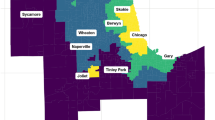Abstract
The relation between the diversity of available housing within the black ghetto and the diversity of demand within the same region is the concern of this study. Specifically, the degree to which the black housing market is able to accommodate the variations in demand by black households is examined. The relation between social and residential distances, which is operationalized by employment of the index of dissimilarity, is used as the means for assessing this degree of housing accommodation. The black population of Milwaukee, Wisconsin is used as a case study, while the white population is included for comparative purposes. Results of the analysis show that the supply and location of housing has failed to provide a housing stock that is diverse enough to accommodate the needs of the city's blacks. Middle class blacks may be effected most by the constrained market, because these house-holds are less able to adjust housing according to income than are lower income groups. As a result of this housing allocation process, the social spatial form of the ghetto may differ substantially from the remainder of the city.
Similar content being viewed by others
References
Blau, Peter, and Otis D. Duncan. 1967.The American Occupational Structure. New York: John Wiley and Sons.
Cortese, Charles F., R. Frank Falk, and Jack K. Cohen. 1976. “Further Considerations on the Methodological Analysis of Segregation Indices.”American Sociological Review 41: 630–637.
Cottingham, Phoebe H. 1975, “Black Income and Metropolitan Residential Dispersion.”Urban Affairs Quarterly 10: 273–296.
Cowgill, Donald O., and Mary Cowgill. 1957. “An Index of Segregation Based on Block Statistics.”American Sociological Review 16: 831–835.
Darden, Joe T. Forthcoming. “The Causes of Black Residential Segregation: Myths and Realities.” In Leo E. Zonn (ed.)Minority Populations and The American City: A Geographic Approach. New York: Halsted Press.
Duncan, Otis D., and Beverly Duncan. 1957.The Negro Population of Chicago. Chicago: University of Chicago Press.
Duncan, Otis D., and Beverly Duncan. 1955. “Residential Distribution and Occupational Stratification.”American Journal of Sociology 60: 493–503.
Duncan, Otis D., and Beverly Duncan. 1961.Statistical Geography. Glencoe, Illinois: The Free Press.
Edwards, Ozzie L. 1970. “Patterns of Residential Segregation Within a Metropolitan Ghetto”Demography 7: 185–193.
Erbe, Brigitte Mach. 1975. “Race and Socioeconomic Segregation.”American Sociological Review 40: 801–812.
Farley, Reynolds. 1970.Growth of the Black Population. Chicago: Markham Publishing Co.
Farley, Reynolds. 1977. “Residential Segregation in Urbanized Areas of the United States in 1970: An Analysis of Social Class and Racial Differences.”Demography 14: 497–518.
Frazier, E. Franklin. 1937. “Negro Harlem: An Ecological Study.”American Journal of Sociology 43: 72–88.
Gibbs, Jack P. 1961. “Some Measures of the Spatial Distribution and Redistribution of Urban Phenomena.” In Jack P. Gibbs (ed.)Urban Research Methods. Princeton: D. Van Nostrand.
Isard, Walter, 1960.Methods of Regional Analysis; An Introduction to Regional Science. New York: John Wiley and Sons.
Jiobu, Robert M., and Harvey H. Marshall. 1971. “Urban Structure and the Differentiation Between Blacks and Whites.”American Sociological Review 36: 638–649.
Kain, John F., and John M. Quigley. 1972. “Housing Market Discrimination, Home-Ownership, and Savings Behavior.”The American Economic Review 81: 263–277.
King, A. Thomas, and Peter Mieszkowski. 1973. “Racial Discrimination, Segregation, and the Price of Housing.”Journal of Political Economy 81: 590–606.
Marston, W. G. 1969. “Socioeconomic Differentiation Within Negro Areas of American Cities.”Social Forces 48: 165–176.
Muth, Richard F. 1968. “Urban Residential Land and Housing Markets.” in H. S. Perloff and L. Wingo (eds.)Issues in Urban Economics. Baltimore: Johns Hopkins Press.
Rhodes, A. Lewis. 1969. “Residential Distribution and Occupational Stratification.”The Sociological Quarterly 10: 106–112.
Rose, Harold M. 1976.Black Suburbanization; Access to Improved Quality of Life or Maintenance of the Status Quo? Cambridge, Mass: Ballinger Publishing Co.
Rose, Harold M. 1970. “The Development of An Urban Subsystem: The Case of the Negro Ghetto.”Annals of the Association of American Geographers 60: 1–17.
Rose, Harold M. 1969.Social Processes in the City; Race and Urban Residential Choice. Washington, D.C.: Association of American Geographers.
Schnore, Leo F. 1972.Class and Race in Cities and Suburbs. Chicago: Markham Publishing Company.
Schnore, Leo F. 1965.The Urban Scene. New York: Free Press.
Simkus, Albert A. 1978. “Residential Segregation by Occupation and Race.”American Sociological Review 43: 81–93.
Sorenson, Annemette, Karl E. Taeuber, and Leslie Hollingsworth. 1975. “Indexes of Racial Residential Segregation for 109 Cities in the United States, 1940–1970.”Sociological Focus 8: 125–142.
Straszheim, Mahlon R. 1974. “Housing Market Discrimination and Black Housing Consumption.”The Quarterly Journal of Economics 88: 19–41.
Taeuber, Karl E., and Alma F. Taeuber. 1965.Negroes in Cities. Chicago: Aldine Publishing Company.
Taeuber, Karl, and Alma Taeuber. 1976. “A Practitioner's Perspective on the Index of Dissimilarity.”American Sociological Review 41: 884–889.
U.S. Bureau of the Census. 1970.Census of Population and Housing: 1970 Census Tracts, Final Report. PHC (1)-131, Milwaukee, Wisconsin, S.M.S.A. Washington, D.C.: U.S. Government Printing Office.
Uyeki, Eugene S. 1964. “Residential Distribution and Stratification: 1950–1960.”American Journal of Sociology 69: 491–498.
Van Valey, Thomas L., Wade Clark Roof, and J. E. Wilcox. 1977. “Trends in Residential Segregation: 1960–1970.”American Journal of Sociology 82: 826–844.
Wheeler, James O. 1971. “Residential Location by Occupational Status.” In Larry S. Bourne (ed.)Internal Structure of the City. New York: Oxford University Press.
Winship, Christopher. 1977. “A Re-evaluation of Indexes of Residential Segregation.”Social Forces 55: 1058–1066.
Yinger, John. 1977. “Prejudice and Discrimination in the Urban Housing Market.”Discussion Paper No. D77-9. Cambridge: Harvard University, Department of City and Regional Planning.
Author information
Authors and Affiliations
Rights and permissions
About this article
Cite this article
Zonn, L.E. Housing and urban blacks: A social distance-residential distance view. Ann Reg Sci 13, 55–65 (1979). https://doi.org/10.1007/BF01284079
Issue Date:
DOI: https://doi.org/10.1007/BF01284079




